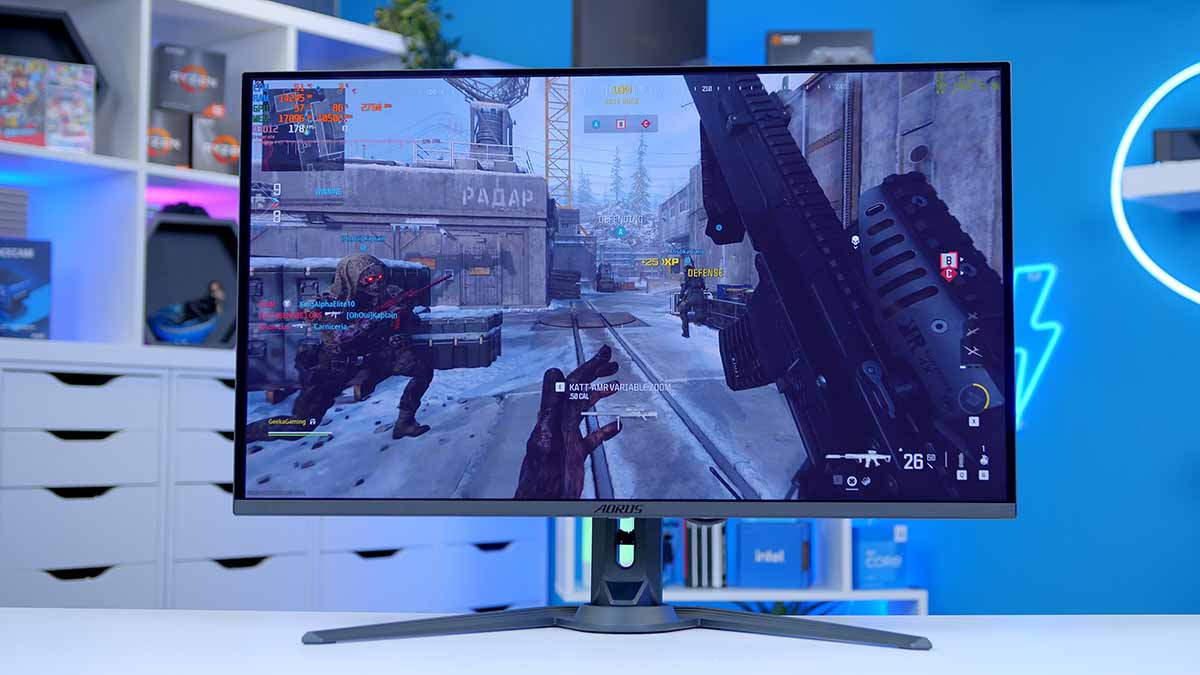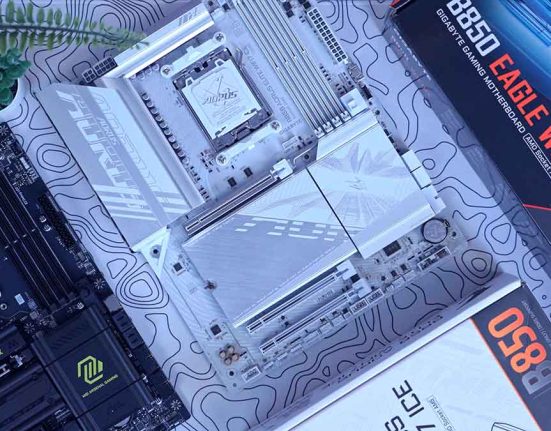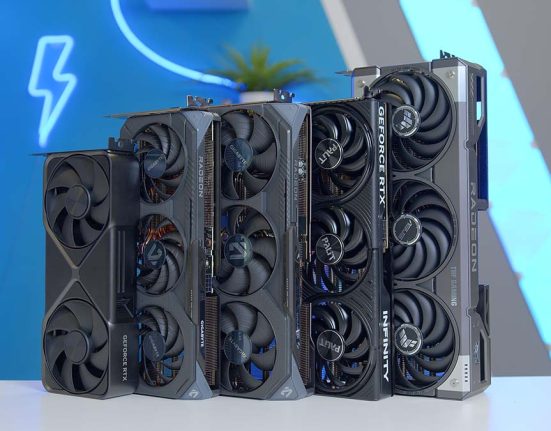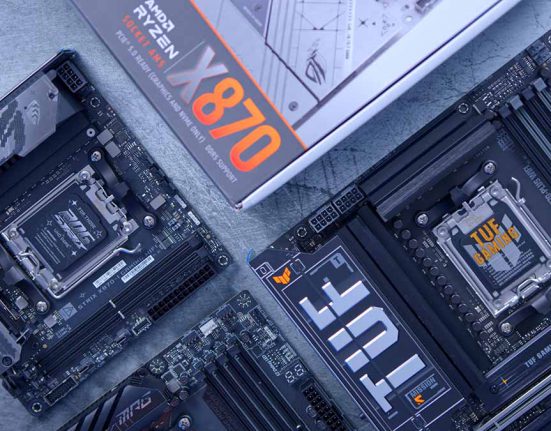The Gigabyte AORUS FO32U2P is a premium 4K QD-OLED display designed to maximise visual fidelity while providing insane bandwidth and plenty of usability features so that it can easily slip into an existing setup. However, with so many QD-OLED monitors hitting the shelves within the past year, the market is oversaturated with high-end displays offering incredibly similar features. We’ve rigorously tested the AORUS FO32U2P to see how it compares to other monitors regarding visual accuracy and performance.
Gigabyte is one of many manufacturers that offer some form of OLED monitor for those looking to enjoy high-fidelity gaming or work on colour-critical content. While we can agree that many of these displays provide peak image quality, they often end up being overpriced or lack unique features that make them stand out compared to the vast selection of options. However, the AORUS FO32U2P has piqued my interest as one of the few 4K OLED gaming displays to provide a 240Hz refresh rate and a way to daisy-chain multiple monitors together.
In this review, we’ll examine the AORUS FO32U2P in detail, analysing its specs, design, features, and performance to see how this unique monitor compares to similarly priced models on the market.
Buy the Gigabyte AORUS FO32U2P on:
Specification
The AORUS FO32U2P monitor offers specs similar to those of other QD-OLED displays we’ve reviewed. At 32 inches, the FO32U2P is large but doesn’t sacrifice image quality despite being a big display. On non-OLED panels, it’s common to see the screen door effect appear, with pixels becoming increasingly visible. But OLED doesn’t suffer from this weakness, so you can still enjoy excellent image quality on a big monitor with minimal drawbacks.

This monitor offers a 4K resolution with a rated refresh rate of 240Hz. For quite some time, 4K displays have been stuck around the 144Hz mark regarding refresh rate, so it’s nice to see a jump up to 240Hz. Admittedly, using this refresh rate depends entirely on the graphics card used, but those with enthusiast-level cards, such as an RTX 4080 SUPER or 4090, can utilise the higher refresh rate. This is assisted by the incredibly low response time, which clocks in at 0.03ms GtG (grey-to-grey), indicating hardware-level responsiveness.
| Key Specs | Gigabyte AORUS FO32U2P |
|---|---|
| Screen Size | 32″ |
| Max Resolution | 3840 x 2160 |
| Refresh Rate | 240Hz |
| Response Time | 0.03ms GtG |
| Colour Gamut | 99% DCI-P3 100% sRGB |
| Peak Brightness | 1000 nits |
| Contrast Ratio | 1500000:1 |
| Panel Type | QD-OLED |
| Display Inputs | 2 x HDMI 2.1 1 x DisplayPort 2.1 in 1 x mini DP 2.1 |
| Additional IO | 1 x DisplayPort 1.4 out 1 x USB Type-C (Up to 65W PD) 2 x USB 3.2 Type-A Downstream 1 x USB 3.2 Type-B Upstream 1 x 3.5mm Earphone Jack 1 x 3.5mm Microphone Jack |
| VRR Technology | AMD FreeSync Premium |
Unfortunately, peak brightness isn’t particularly impressive. The vast majority of OLED monitors tend to sit at 1000 nits with HDR-enabled, which is a limitation of OLED panels. But despite this, the AORUS FO32U2P still feels incredibly bright. The contrast ratio is also excellent, sitting at 1.5 million to one. This denotes solid colour accuracy.
IO is very strong. On the display front, there are two DisplayPort ports and two HDMI ports, all of which use the 2.1 standard. Additionally, Gigabyte has included a DisplayPort 1.4 output, which is used to daisy-chain signals to multiple monitors. Alongside this, there are four USB ports. The USB Type-C port provides up to 65W of power delivery, while the USB Type-B port is upstream, so this is used to provide data to the other ports on the monitor.

Regarding pricing, the AORUS FO32U2P sits at $1199.99 at the time of writing. Unfortunately, this does make this monitor one of the pricier options compared to the MSI MPG 321URX QD-OLED or Gigabyte’s very own AORUS CO49DQ. However, as we can see from the specs, there is a clear focus on usability, especially concerning IO. As we’ll discover through testing, later on, the AORUS FO32U2P takes the cake regarding visual fidelity.
Suggested Article: MSI MPG 274URF QD Gaming Monitor Review
Gigabyte AORUS FO32U2P Design
Like other Gigabyte monitors we’ve reviewed previously, the AORUS FO32U2P is incredibly sleek and utilises a slimline frame with a premium metal chassis. The bottom bezel supporting the monitor panel is small and features a centralised AORUS logo. Surrounding the monitor are three relatively small bezels backed by a thin plastic frame. It’s nice to see a skinnier design on a monitor, as we’re typically used to chunkier monitors with a bulkier chassis.

Moving to the back of the FO32U2P, the slimline design persists, with the plastic backing only bulking up towards the centre, where most of the hotter components will be. While it would be great to see some flecks of metal on the back of the monitor, I’m a fan of Gigabyte’s approach to the minimalist look.

At the top of the rear, you’ll find a small strip of RGB. While this won’t be particularly visible during the daytime, it provides additional lighting for your setup and is a fantastic showcase piece.

The stand of the FO32U2P is exceptionally robust and rigid, with a metal base that uses two angular feet. It feels incredibly sturdy and reduces wobble significantly when screwed in tightly.

On the base pillar you’ll find a plastic shroud to cover the metal and a small cutout in the middle for any cables. This cable cutout is relatively slimline, so cables like kettle leads aren’t likely to easily pass through. However, it features a small bungee to keep your wires organised.

100mm VESA mounting is supported on the FO32U2P, making the stand optional. This allows you to mount the monitor on an arm or wall, clearing up desk space.

For adjustability, the FO32U2P offers 20 degrees of tilt and swivel and 90 degrees of pivot. It can also be flipped to display vertically, ideal for file management or content creation. There’s also 130mm of height adjustment, providing an easy way to fit into an existing setup.

The OSD (on-screen display) joystick is located just underneath the AORUS logo towards the front of the display. It’s surrounded by two buttons on the left and right, along with a white LED at the front. While facing the monitor, the left button is a tactical switch, which can be programmed to do various things, similar to a macro key. The right button triggers the KVM switch, which is helpful for those with multiple machines.

Features We Like
Bountiful IO
The AORUS FO32U2P offers a robust set of IO regarding display inputs and additional ports. All main display inputs use the 2.1 standard (HDMI and DisplayPort), which provides an exceptional amount of bandwidth for high visual fidelity content.

This also means that the monitor doesn’t need display stream compression to squeeze through all of the data, resulting in uninterrupted data flow, ideal for HDR and 10-bit colour, which this display supports.

Daisy-Chainable Display Signals
One of the FO32U2P’s more unique qualities is that it supports daisy-chaining through a single data cable. This means you don’t need to plug multiple monitors into a limited number of graphics card outputs, which is a great feature and significantly reduces cable clutter. Additionally, daisy-chaining isn’t restricted to Gigabyte displays, offering an easy way to connect multiple monitors simultaneously.

OLED Care & OSD Customisation
The FO32U2P features a vast range of customisation options in the OSD, allowing enthusiasts to enjoy a bespoke visual experience. The ‘Gaming’ tab has four main settings: Black Equalizer 2.0 increases the detail of deeper blacks, while Super Resolution enhances overall visual quality. The Display Mode setting changes the aspect ratio, which is incredibly useful for those with smaller monitors looking to line up their screens perfectly.

The ‘Picture’ tab has preset options for colour settings, while the ‘Display’ tab allows you to change settings such as the KVM switch, the Daisy Chain mode, and RGB Range.

Further settings can turn USB ports on and off, change the ‘Quick Switch’ options, and amend the DisplayPort and HDMI versions. The OSD on the AORUS FO32U2P has plenty of customisation, and it’s impressive how much Gigabyte have managed to squeeze in.

Additionally, the ‘OLED Care’ settings are equally vast and offer a range of ways to minimise burn-in and clean up pixel shifting. This tab also shows screen uptime information indicating when the pixel cleaning should be rerun.

Features We Don’t Like
Limited Refresh Rate with Daisy-Chaining
Unfortunately, the biggest drawback of the daisy-chaining support is that it requires DisplayPort 2.1 UHBR20. While it’s great to see this standard being supported, at the time of writing, there aren’t any consumer desktop graphics cards that can output at UHBR20 bandwidth. Because of this, daisy-chaining multiple monitors together results in the refresh rate dropping to 165Hz or less.
While it’s much harder to reach framerates this high in most modern titles, Esports games are far less demanding, making a 240Hz refresh rate much more viable. While I commend Gigabyte for its usability feature, it seems to have come out slightly ahead of its time. With the new RTX 5000 and Radeon 8000 graphics cards set to release in Q4, prospective buyers need to wait sometime to utilise the capabilities of the AORUS FO32U2P fully.

Colour Accuracy & Image Quality
After benchmarking the Gigabyte AORUS FO32U2P over many days, it is clear that this monitor was designed to offer exceptional visual fidelity out of the box. The current generation of OLED panels is incomparable to non-OLED monitors. The colours look vibrant, while the movement is exceptionally smooth. I tested the AORUS FO32U2P in Destiny 2: The Final Shape, running around in the Pale Heart of the Traveller, and the game has never looked more beautiful.
I could look at the finer details of the wood panelling in The Tower and observe the rich hues of blue and green in the water in The Landing. This monitor is a winner purely on the image quality, especially in games where OLED panels can flex their muscles.
However, as a QD-OLED display, the AORUS FO32U2P can provide high colour accuracy and contrast, making it a competitor in the workstation space. However, to see if these claims are valid, we first need to discern how accurate the FO32U2P is compared to other OLED displays on the market.

To do this, we fired up the Datacolor Spyder X Pro, which features across all of our monitor reviews. We then ran the ‘FullCAL’ benchmark, which analyses colours shown on the display and then returns a result showing the coverage in each gamut. The primary data we record is sRGB and DCI-P3; the former is used for web content, while DCI-P3 is commonly used for colour-critical and HDR content.
After running this benchmark, we saw 100% coverage of the sRGB space and 96% coverage of DCI-P3. The latter is the more important of the two, as Gigabyte claims a 99% coverage in comparison. While this 3% difference isn’t gigantic and is well within the margin of error, it’s still interesting to see how the advertised claims compare. It’s worth noting that the AORUS FO32U2P is calibrated with a Delta E of less than 2. This means the monitor shows colours and images very close to what the human eye can see, synergising very well with the high colour accuracy.
Conclusion
Gigabyte AORUS FO32U2P

Product Name: AORUS FO32U2P
Brand: Gigabyte
-
Features
-
Design
-
Performance
-
Value For Money
Summary
The Gigabyte AORUS FO32U2P is one of the strongest QD-OLED displays on the market right now. This display offers effectively unrivalled image quality, producing excellent colour hues, deep blacks, and light whites while providing blazing-fast responsiveness. I was taken aback by the visual fidelity that this monitor offers, and there are very few options that we’ve reviewed previously that come even remotely close. Furthermore, the AORUS FO32U2P is a monitor that caters to both workstations and gamers, as it covers a wide range of colour gamuts and is rated with a Delta E of less than 2, making it ideal for HDR and colour-critical content. To top it off, the built-in OSD offers a massive amount of customisation and a range of ways to clean and maintain the OLED panel through the ‘OLED Care’ settings.
The two main drawbacks of the AORUS FO32U2P are the price and daisy-chain technology. At $1199.99, the FO32U2P is pricey, coming in about $200-$300 more than similar monitors like the MSI MPG 321URX QD-OLED. Additionally, the daisy-chain technology has come out ahead of the available hardware, as no consumer desktop GPUs support UHBR20, limiting the refresh rate significantly when daisy-chaining to other displays. However, as one of the best QD-OLED monitors on the market, I think these are relatively small caveats.
Pros
✅ Unrivalled image quality
✅ Vast OSD customisation
✅ IO selection
Cons
❌ Expensive
❌ UHBR20 unsupported with current-gen GPUs
❌ Daisy-chain refresh rate



![FI_[DM78] Corsair Air 5400 + 5090 Gaming PC Build](https://geekawhat.com/wp-content/uploads/2025/11/FI_DM78-Corsair-Air-5400-5090-Gaming-PC-Build-551x431.jpg)

![FI_[DM76] HAVN BF360 5090 Build](https://geekawhat.com/wp-content/uploads/2025/10/FI_DM76-HAVN-BF360-5090-Build-1-551x431.jpg)


